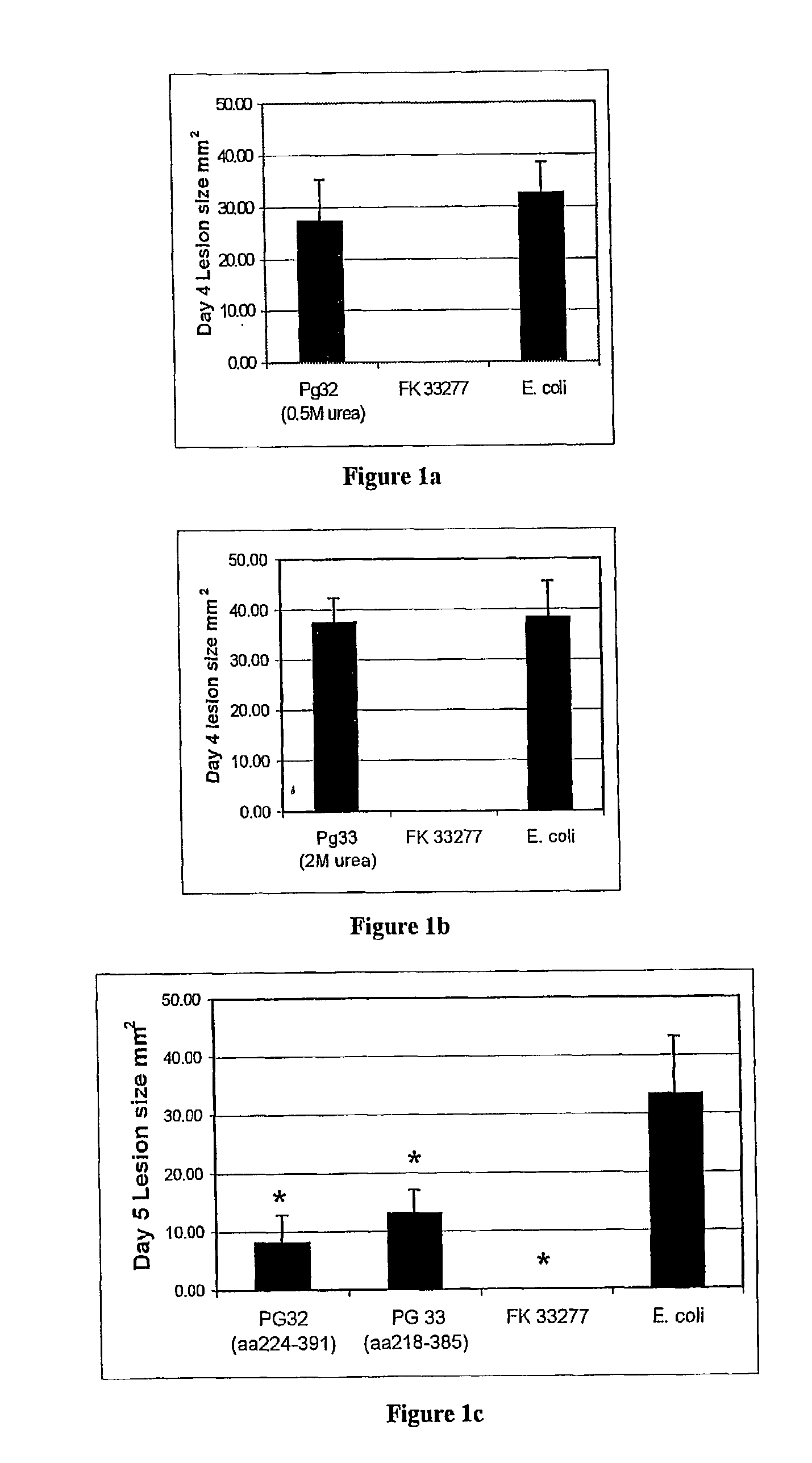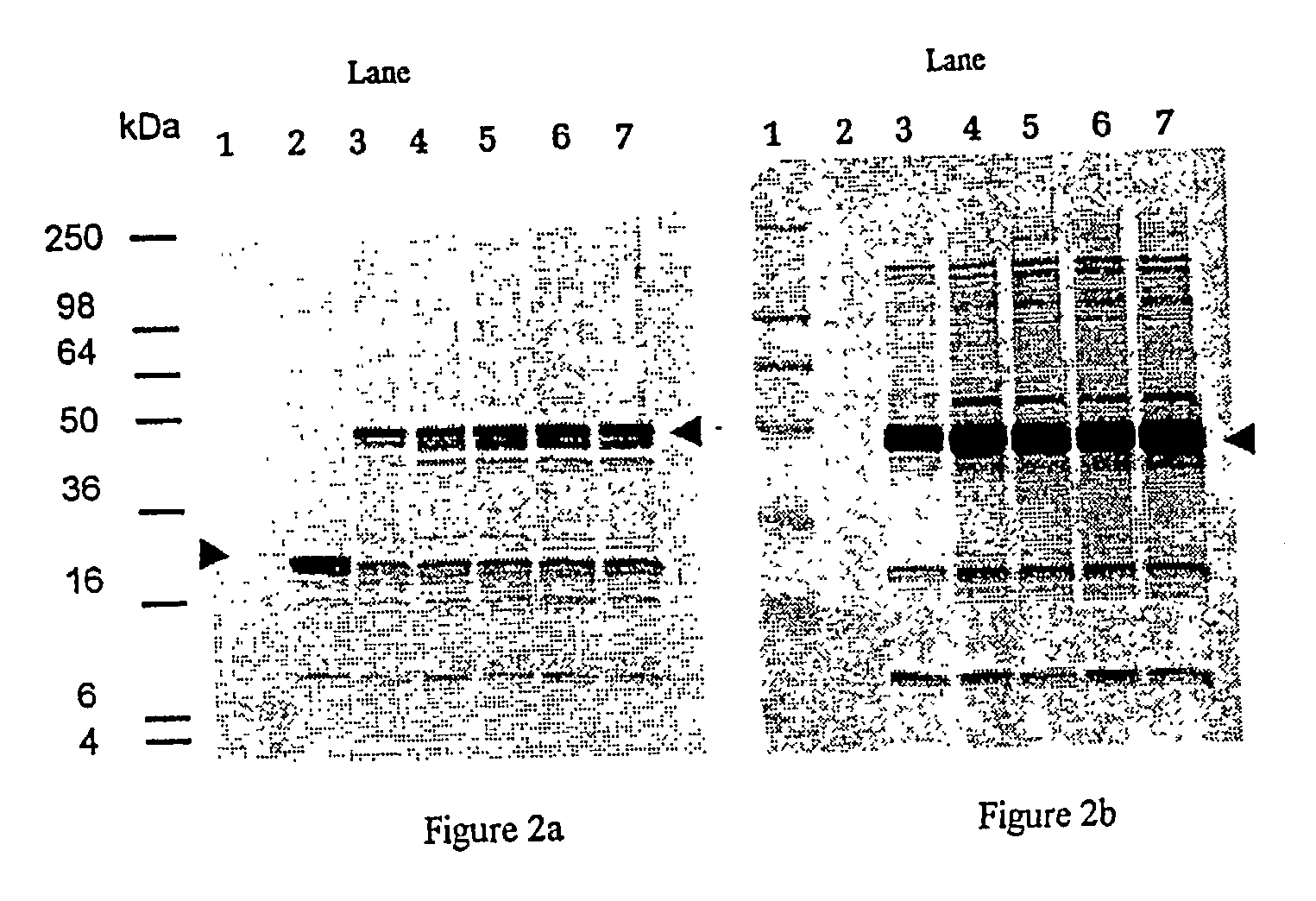Porphyromonas gingivalis recombinant proteins and truncations
a technology of porphyromonas gingivalis and recombinant proteins, applied in the field of p . gingivalis nucleotide sequences and p . gingivalis polypeptides, can solve the problems of difficult to isolate and grow, large public health problems, and difficult identification of these molecules by conventional methods, and achieve the effect of improving solubility
- Summary
- Abstract
- Description
- Claims
- Application Information
AI Technical Summary
Benefits of technology
Problems solved by technology
Method used
Image
Examples
example 1
Cloning and Analysis of the P. gingivalis Recombinant Proteins PG32 and PG33 and Fragments or Truncations of these Proteins
(a) Cloning of the P. gingivalis Truncated Proteins
[0095]PG32 (GENBANK accession number AF175714) and PG33 (GENBANK accession number AF175715) have previously been described as immunoreactive proteins of P. gingivalis strain W50. The complete DNA sequence and protein sequence for PG32 are given in SEQ ID NOs: 1 and 3 respectively and for PG33 in SEQ ID NOs: 2 and 4 respectively.
[0096]Both PG32 and PG33 recombinant proteins along with several truncations of these proteins (Table 2) were cloned and expressed in E. coli.
[0097]Using the oligonucleotide primers listed in Table 2, full length PG32, PG33 (with their leader sequences removed) and a number of fragments from PG32 and PG33 were PCR amplified from purified P. gingivalis W50 genomic DNA using Pfu DNA polymerase (PROMEGA) and a PTC-100 thermal cycler (MJ RESEARCH). The PCR reactions used the following condit...
example 2
Antisera
[0106]Polyclonal antiserum was raised to the purified recombinant proteins by dosing BALB / c mice with 2×20 μg of the PG32 (construct 21) recombinant protein in Freunds incomplete adjuvant (FIA; SIGMA) three weeks apart. Mice were bled one week after the second dose and the antiserum generated was used to screen Western blots of whole cell P. gingivalis W50 run under denaturing and reducing conditions. Antisera were also raised in rabbits by immunisation with 3 doses of either whole P. gingivalis cells (strain W50) or SARKOSYL insoluble enriched fractions (a method which enriches for outer membrane proteins of gram negative organisms) of P. gingivalis (strain W50) in FIA. Antisera were also raised in rats following immunisation with whole P. gingivalis W50 cells in Freunds Incomplete adjuvant. The rats were then challenged orally with live P. gingivalis cells (strain ATCC 33277) and bled 6 weeks later. These rats were later shown to be protected from alveolar bone loss around...
example 3
Murine Lesion Model
[0108]Groups of 10 female BALB / c mice (6–8 weeks old) were immunized (20 μg / dose) subcutaneously with each recombinant protein, PG32 (Construct 1 in 0.5M urea), PG33 (Construct 2 in 2M urea), PG32 fragment (Construct 21) and PG33 fragment (Construct 22). Control mice were given formalin-killed P. gingivalis cells (approximately 2×109, or E. coli lysate (20 μg / dose); all emulsified in Incomplete Freunds Adjuvant (SIGMA). The immunizations were given subcutaneously at the base of the tail and occurred four weeks and one week prior to challenge with P. gingivalis . Two days prior to challenge mice were bled from the retrobulbar plexus. BALB / c mice were challenged with 7.5×109 viable cells of P. gingivalis 33277 subcutaneously into the ventral region of the abdomen. Following challenge, mice were examined daily for the number and size of lesions over a period of seven days. Lesions developed on the abdomen of the mice around the injection site and the lesions were mea...
PUM
| Property | Measurement | Unit |
|---|---|---|
| Atomic weight | aaaaa | aaaaa |
| Atomic weight | aaaaa | aaaaa |
| Atomic weight | aaaaa | aaaaa |
Abstract
Description
Claims
Application Information
 Login to View More
Login to View More - R&D
- Intellectual Property
- Life Sciences
- Materials
- Tech Scout
- Unparalleled Data Quality
- Higher Quality Content
- 60% Fewer Hallucinations
Browse by: Latest US Patents, China's latest patents, Technical Efficacy Thesaurus, Application Domain, Technology Topic, Popular Technical Reports.
© 2025 PatSnap. All rights reserved.Legal|Privacy policy|Modern Slavery Act Transparency Statement|Sitemap|About US| Contact US: help@patsnap.com


